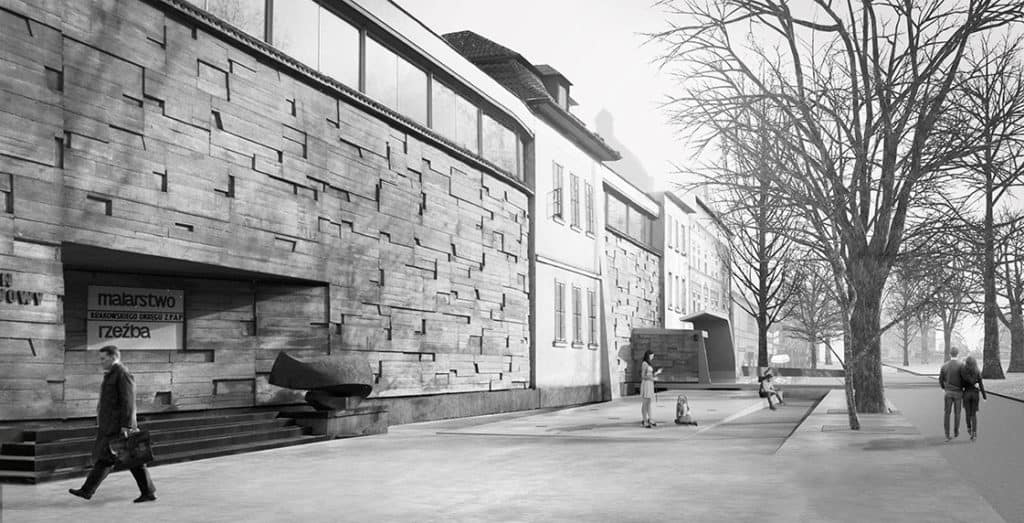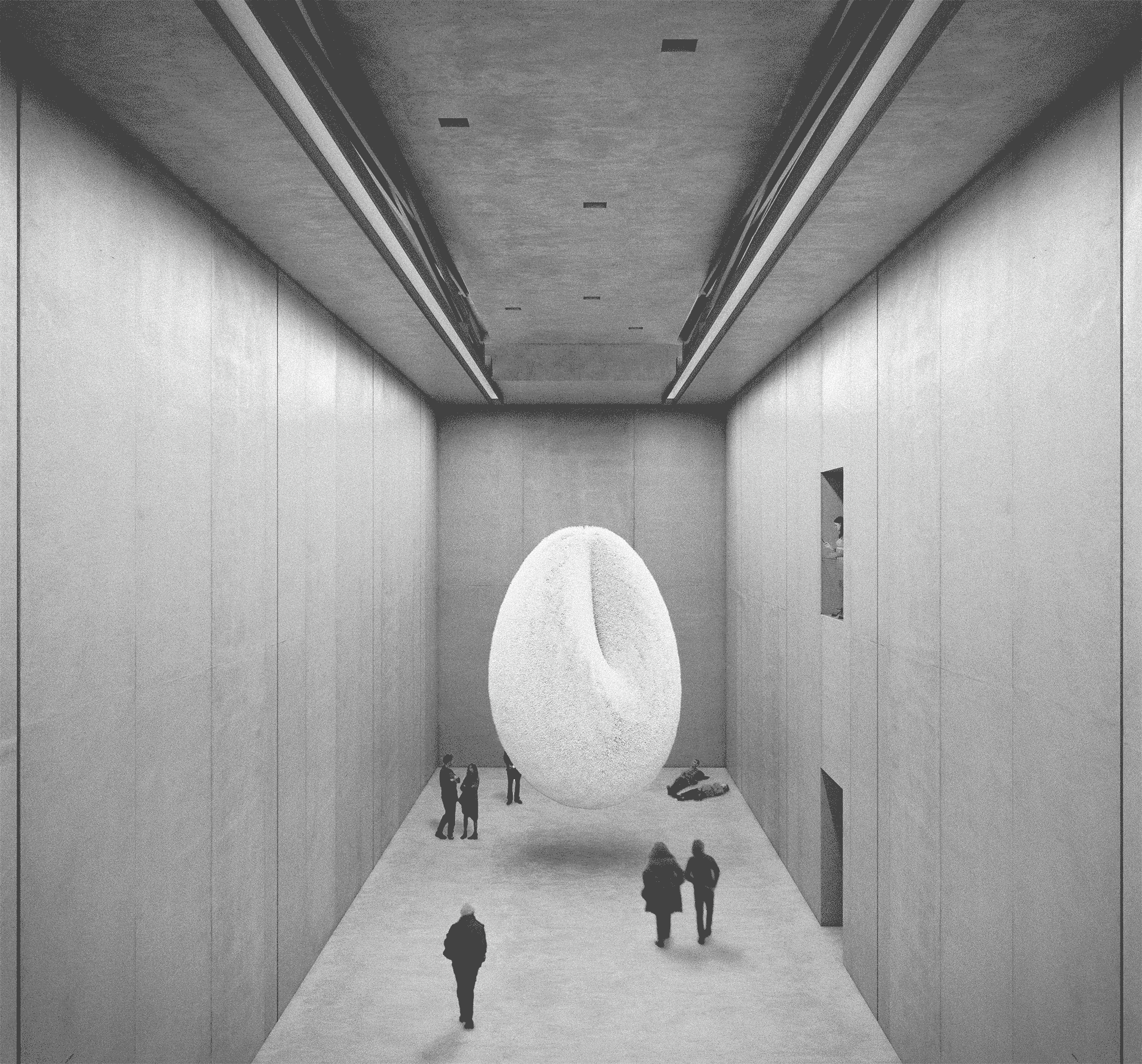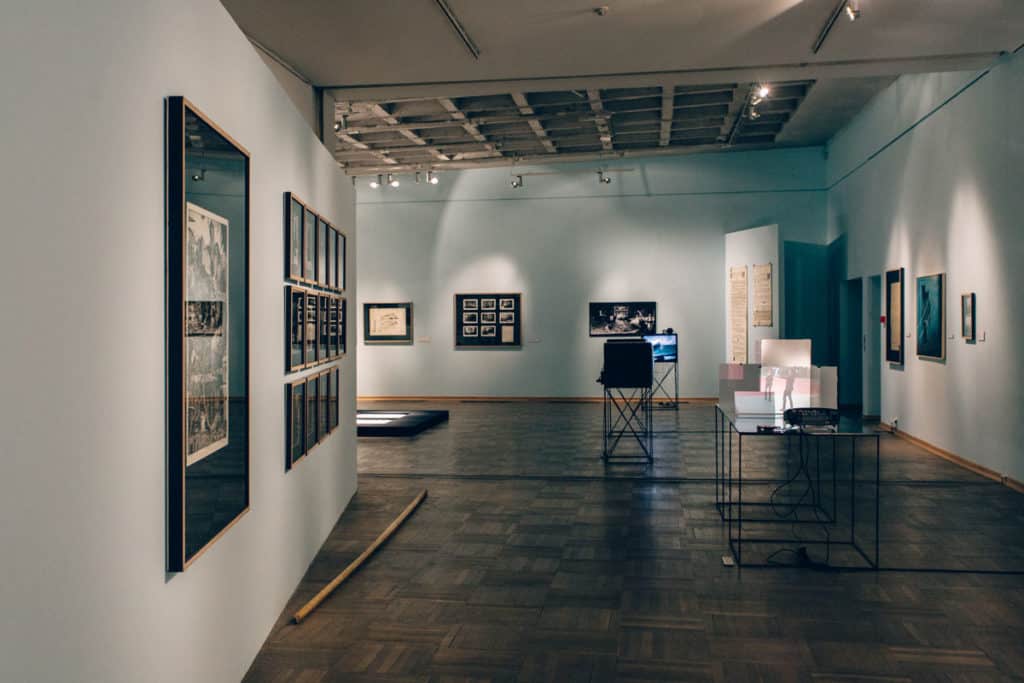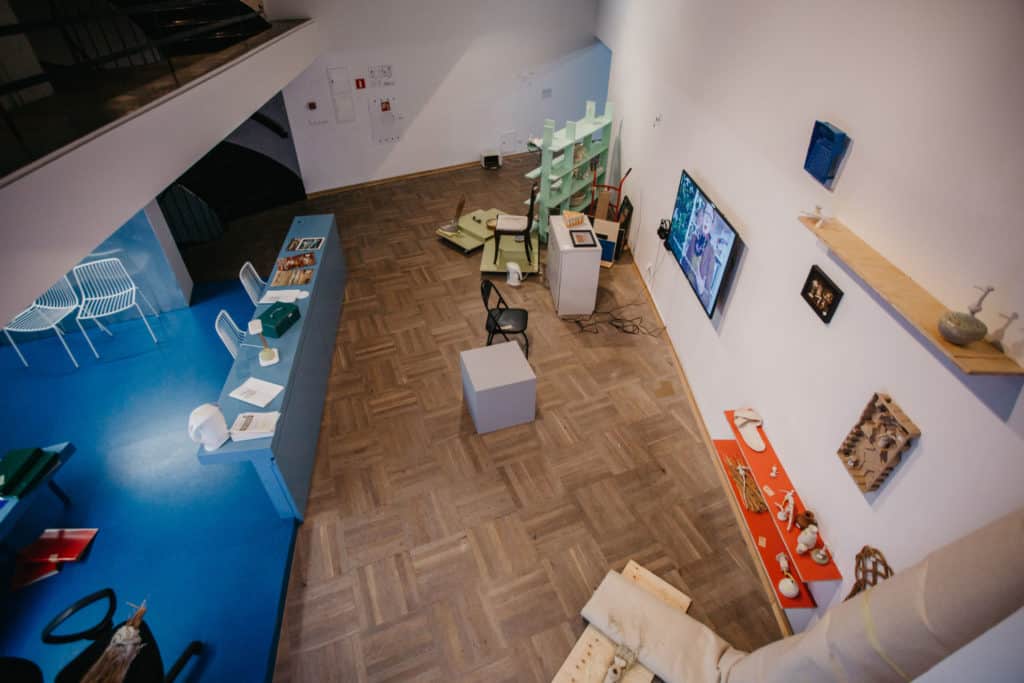Ziółkowska Magdalena, photo Studio FilmLOVE
Dobromila Blaszczyk: This year, the legendary Krakow institution, Bunkier Sztuki Gallery of Contemporary Art, celebrates its seventieth anniversary. On this special occasion you have announced a competition to select an architect to design Bunkier Sztuki’s new building and to conduct a complete renovation, modernisation, and restoration of the original architecture’s elements. Could you tell us more about the scope and direction of the imminent modifications?
Magdalena Ziółkowska: To say that the current Bunkier Sztuki Gallery and former Municipal Exhibition Pavilion (1959-1961), which was designed by Krystyna Tołłoczko-Różyska to showcase works of contemporary art, holds us literally and figuratively back is a gross understatement, indeed. Sixty years ago, the Pavilion opened its doors to numerous visitors and events. Now it’s high time the building undergoes thorough conservation, restoring the interior to its former glory. An unprecedented sensation of the façade’s deep deterioration, frailty, gradual decay and resistance to the inevitable is overwhelming and clearly palpable every single day. Therefore, our art collection reflects unavoidable changes in architecture as far as its pulse and vitality are concerned. Several years ago, we collaborated with artists for whom the diverse parameters of the building, its essence, acoustics, lighting and signs of time passing, were of paramount importance to their practice. Those artists included Maria Loboda, Anna Zaradny, Yane Calovski, Mateusz Kula, Monika Niwelińska and Katarzyna Krakowiak. The building designed by Tołłoczko-Różyska, an esteemed member of the first-generation of Polish modernists, serves as the intriguing and only example of brutalist architecture in Poland. Her design transcends a dogma of raw form and concrete epitomised by Kenzo Tange, for instance. New architectural quality emerged amidst a narrow historic frontage of the Krakow Planty through the incorporation of some original components into the building’s structure, such as a series of windows positioned directly below the roof and sculptured clapboard façade. The authors of an impressive monograph entitled “SOS Brutalism A Global Survey” (2017) have recently lauded the design’s novelty, scale and panache, as well as the curators of an exhibition held in the Architecture Museum in Frankfurt that featured our “Exhibition Pavilion” in the key section of the exhibit devoted to architectural gems from Central Europe.

Bunkier Sztuki Gallery of Contemporary Art, photo Studio filmLOVE

Bunkier Sztuki Gallery of Contemporary Art, KWK-PROMES, visualization
DB: Necessary renovation and modernisation is one thing, the limited activity of a public institution of culture is yet another. Visitors of every institution that closes its doors for a while, regardless of its location and context, are bound to wonder what’s next. It’s absurd to think the institution and its employees would go into enforced hibernation to emerge only after the overhaul and new building are complete. Could you give us some insight into the timeline and your plans for this period of transition?
MZ: Currently, we’re preparing a detailed design and construction documentation in order to submit the application for a construction permit to the Municipal Architecture Department. Furthermore, we look forward to the official announcement of this year’s operational programmes since the future of this investment and gallery’s restoration depend on large subventions from government. A detailed investment calendar notwithstanding, we view our move in terms of a challenge and opportunity to reevaluate the strategy we’ve followed so far. This summer, we’ll launch a series of outdoor events among greenery dedicated to our neighbours, such as screenings of films about art and ecology, lectures, meetings and family friendly workshops. We’ll also stage an outdoor exhibit pertaining to the renovation. Temporary headquarters trigger certain correlations and interdependencies, impel our staff members to step outside of their comfort zones, break a daily routine, their usual line of thinking and operating in order to unlock an untapped potential we currently might be incapable of specifying or predicting. We aren’t going to scramble for survival, let me assure you. Instead, we intend to enter into an uncharted territory by launching a variety of interdisciplinary art projects in collaboration with other institutions of culture.

Bunkier Sztuki Gallery of Contemporary Art, KWK-PROMES, visualization, interior
DB: It seems like a perfect opportunity to reconsider the role of exhibition space while considering the institution’s general function and status. What function should be ascribed to a public cultural institution?
MZ: The operation of a public cultural institution is financed by some local government agent, which by no means suggests that it should only act locally. What fascinates me about this sort of predicament is the occasion to penetrate into those spheres of artistic milieu in the city that are virtually impenetrable for national museums founded to preserve heritage. Our strategy is based on recognising trends and practices that flourish in a particular artistic microclimate, as well as creating favourable conditions for their development and dissemination (i.e. networking and marketing). Bunkier Sztuki Gallery of Contemporary Art disassociates itself from a retrospective outlook on art. “What we look for in the past, depends on the things that plague the present,” Ewa Domańska once wrote. Our references to any historical context stem from our interest in the all-encompassing political, social and artistic transformations that can have major implications for the general public now, as seen in Krzysztof Pijarski’s “Sztos,” the “Gestures of Disappearance” exhibition, the “Concealed” art project celebrating Janusz Kaczorowski and Maciej Jerzmanowski, the reenactment of the “Romantic Manifestation” performance by Janusz Bereś, and so forth. The seismographic effect is encapsulated by our flagship project entitled “Seismograph. Young Emerging Artists of the Małopolska Region” (2016) that encompasses a series of competitions, artist-in-residence programmes, temporary art shows and local biennales. The networking events aimed at curators from Poland and abroad who work with younger generations of artists, draw on the intangible aspects of their practice, namely conversations, emotions and human interactions with no strings attached.
The way in which any public cultural institution operates reminds me of being stuck in traffic, sitting restless in your car surrounded by other cars that never move an inch. Suddenly, you hop on your bike and charge ahead, leaving the others far behind. Your vigilance and swift reaction derive from flexibility and a certain freedom to play something by ear. A challenge spurs us on. Our chief aim is to unearth, define and investigate the intricacies of the modern world.

„All Mounds Can Be Seen from My Window”, photo Studio FilmLOVE, (2016)
DB: Who’s your target audience? Are they still local residents or do the times we live in force you to reckon with national and international audiences? What sort of art exhibitions would actually resonate with today’s viewer immersed in today’s world?
MZ: No exhibition panders to the needs of its intended target audience, whoever its members might be. Obviously, we’re perfectly aware of the fact that our exhibitions attract mostly not only young people, students or university graduates, but also tourists and foreigners who are curious, insightful and seasoned consumers of high culture products. When they visit Krakow, a contemporary art gallery is always on their agenda.

„All Mounds Can Be Seen from My Window”, photo Studio FilmLOVE, (2016)
DB: In one of your interviews, I stumbled upon an excellent phrase you used to discuss your art collection, “potential and tools for imaging the unimaginable.” Wouldn’t you agree that it could also be applied to an art institution? A potential of space, potential of countless possibilities and openness leading to the ultimate implementation of some idea or art project. It’s an invitation to discover and explore potential areas of interest to the institution, isn’t it?
MZ: In one of his lectures, Miško Šuvaković, art critic and historian from Belgrade, made a noteworthy observation about the types of art institutions founded after the war in Central and Eastern Europe. Šuvaković distinguished the so-called phantom institutions operating alongside alternative artistic and curatorial initiatives overseen by private or semiprivate art centres, or as part of some political movement. On the one hand, the fictitious quality of a phantom institution indicates that it constitutes merely the representation of an idea of a purely conceptual nature. On the other hand, a venue mimics the organising structure and formula adopted by recognisable institutions of culture. In other words, a phantom institution shaped the field between existence and inexistence, illusion and reality, which it could never transcend anyway. Šuvaković’s analysis is as relevant today as it was back in 2011. Phantom stands for a mirage of the past, a figment of someone’s imagination, which keeps resurfacing. Additionally, the term denotes something artificial that seems real, used for a practical or didactic purpose. A familiar framework envelops the “impossibly impossible” structure that emulates ubiquitous, conventional and unthreatening forms with the view of lulling people into a false sense of security. I can’t help but feel that such constructs have gained a lot of traction. Consequently, it’s our duty to redefine our place in the world. Should we scour for answers in the discussions, debates, antiestablishment conceptual art projects and attempted reforms of museums held back in the 1960s which we enjoy reminiscing about and fetishising their potential and impact on the situation we’ve found ourselves in? The jury is still out on that. Personally, I relate much more to the looters’ anthem “Every crisis is an opportunity” espoused by raging vanguards, disobedient and rebellious figures appearing in Ines Doujak’s art installation. We’re sensitised by those people to the outcries typically smothered by the mundane, to the infectious leprosy of intolerance, alienation and hostility.

Ines Doujak, Masterless Voices”, photo Studio FilmLOVE, (2017)
DB: Your exhibition programme seems to be based upon obscure theories behind curatorial practices and the cerebral rather than emotional response to art, which makes me wonder about the type of viewer who attends your exhibitions. Is this person simply keen on contemporary art? Judging from your multiple projects designed for “artworld insiders,” networking events for artists and curators, conferences on obscure subjects and deeply theoretical underpinnings of each exhibition, an ideal member of your target audience would be a highbrow art professional. Or generally speaking, what’s the difference between a Polish consumer of culture and their foreign counterpart?
MZ: In my opinion, there’s no pre-established set of attributes any consumer of culture should possess. First of all, what does a cultured person do exactly? Visit a museum or a galley, watch broadcasts about culture, read particular magazines or perhaps declare their interest? Rarely does someone step into Bunkier Sztuki by chance. Usually, random tourists tend to stop by the gallery since it’s located in close proximity to the Main Square. On the whole, I dare say our visitors perceive contemporary art and culture in terms of a juxtaposition of the past and present, a feast for their eyes, imagination and mind.
Simultaneously, Bunkier Sztuki hosts two or three closely intertwined art exhibitions that together build a thematically coherent narrative, which gradually evolves. Each chapter (the literary terminology is fully intentional) has a leading motif, such as “engineering and grammar,” “imperative,” “zero point,” “test card” etc. Time is our ally, not our enemy. What our displays may have in common is the way they take hold of both the gallery space and the viewers’ own imagination. Occasionally, they make you anxious and uncomfortable, knock you off balance, and nourish your sensibility or powers of observation. We take great strides to create a self-contained coherent and harmonious design of an exhibition on all three levels. For this reason, we refuse to jump on the bandwagon and include generational art reviews and group shows featuring academics or works by esteemed graduates’ in Bunkier Sztuki’s exhibition programme. Our understanding of a genuine art exhibition entails the creation of a multidimensional yet consistent composition.

Anna Zaradny, „Rondo Denoting Circle”, photo Studio FilmLOVE, (2016)
The Exhibition Pavilion, situated in the left wing of the building, defies the convention we’ve adopted. The venue accommodates an open specialised library of publications on curatorial and institutional practice, history and theory. In the Exhibition Pavilion, we hold discussion panels, seminars and workshops. Professional artists, lecturers and students can use this space to organise their own meetings. The issues surrounding the role of contemporary art and critics were also touched upon in the exhibition entitled “All mounds can be seen from my window” that showcased, among others, “Future Vocabularies” (initiated in 2014 by BAK in Utrecht), “Towards Lexicon of Usership” by Stephen Wright, as well as Michael Portnoy and Dan Fox’s work-in-progress concerning future disciplines of art.

”The Trouble with Value”, photo Studio FilmLOVE, (2017)
DB: You’ve already mentioned your audience. What about the art, attitudes, narrative and themes represented by the gallery?
MZ: The activity of Bunkier Sztuki, which comprises not only exhibition management but also publishing, reflects the times we live in and experiences we identify and embrace or, on the contrary, disregard. On many occasions, our exhibitions broach the subject of a selective historical memory, as was the case last autumn when we staged the shows “A New Region of the World” and “Masterless Voices” by Ines Doujak. Side by side with the artists, we’ve emerged victorious from the depths of social injustice and postcolonial inequality to probe into fluid identities, crossbreeding animals, the limits of our consciousness and the power of nature. Furthermore, our two current exhibitions, “The Trouble With Value” and “Communicating Vessels”, ask questions relating to a work of contemporary art’s origin, tradition, form, contours, logic and mechanism governing various (symbolic, financial, cognitive, cultural and semantic) systems it functions in. Quite recent works of art were juxtaposed against twentieth century pieces by, for instance, Mladen Stilinović, Jacek Tylicki, Timm Ulrichs and Feliks Szyszko.

”The Trouble with Value”, photo Studio FilmLOVE, (2017)
DB: Is there any individual or an institution that has exerted a profound influence on your perception of art and represents the level of expertise and sophistication you aspire to?
MZ: Those who manage to recalibrate my way of thinking are the artists themselves – unwavering, audacious, driven and refined artists, I might add – such as Marysia Lewandowska, Sanja Iveković, and (since recently) Ines Doujak or Naeem Mohaiemen, whose solo show opens in September.
Magdalena Ziółkowska – PhD in Art History, curator, graduate of the Art History Institute at the Warsaw University, Graduate School of Social Research and Curatorial Training Programme in de appel arts centre in Amsterdam (2006/2007). In 2013 she earned a doctoral degree for her thesis on the concept of the Museum of Recent Art in Wrocław, and Polish museum studies in 1960s, as well as institutional reforms in Europe. In 2006–2010 she was a guest curator at Van Abbemuseum in Eindhoven, where she implemented projects such as Notes From the Future of Art. Selected Writings of Jerzy Ludwiński (2007) and Andrzej Wróblewski. To the Margin and Back (2010). She collaborated with the Museum of Art in Łódź between 2008–2014, and is the is the author of projects such as Art Always Has Its Consequences (2008–2010), Working Title: Archive (2008–2009), Sanja Iveković. Practice Makes the Master (2009), Eyes Looking for a Head to Inhabit (co-curator, 2011), Hüseyin Bahri Alptekin. Facts, Incidents, Accidents, Circumstances, Situations (co-curator, 2013–2014). Lately she has edited the Teoria Sztuki Zbigniewa Dłubaka anthology (Warsaw 2013) and co-curated the Only to melt, trustingly, without reproach exhibition (Škuc galerija, Lublana 2013–2014). Since 2012, she has been the co-founder and vice-president of the Andrzej Wróblewski Foundation, the co-curator of the Andrzej Wróblewski exhibition Constantly Looking Ahead (National Museum, Cracow 2012–2013) and the author of the bi-lingual monograph of the artist Avoiding Intermediary States. Andrzej Wróblewski (1927–1957). Since January 2015 the director of the Bunkier Sztuki Modern Art Gallery in Cracow.









